A Report on Challenges and Solutions in Teaching Visual Arts
VerifiedAdded on 2021/06/15
|6
|1286
|375
Report
AI Summary
This report examines the challenges encountered by a visual arts teacher, focusing on resource limitations, curriculum integration, and time constraints. The teacher's experiences, gleaned from an interview, highlight issues such as insufficient materials, lack of time for comprehensive lesson delivery, and the need to balance school lesson plans with the Australian Curriculum. The report suggests potential solutions, including leveraging resources from the Tasmanian Art Teachers Association (TATA), the Australian Curriculum, Assessment And Reporting Authority (ACARA), and Arts Pop. The report emphasizes the importance of advocating for visual arts education and allocating more resources and time to the subject to foster student development. The conclusion underscores the significance of understanding the value of visual arts for students and calls for greater support from administrators and parents.
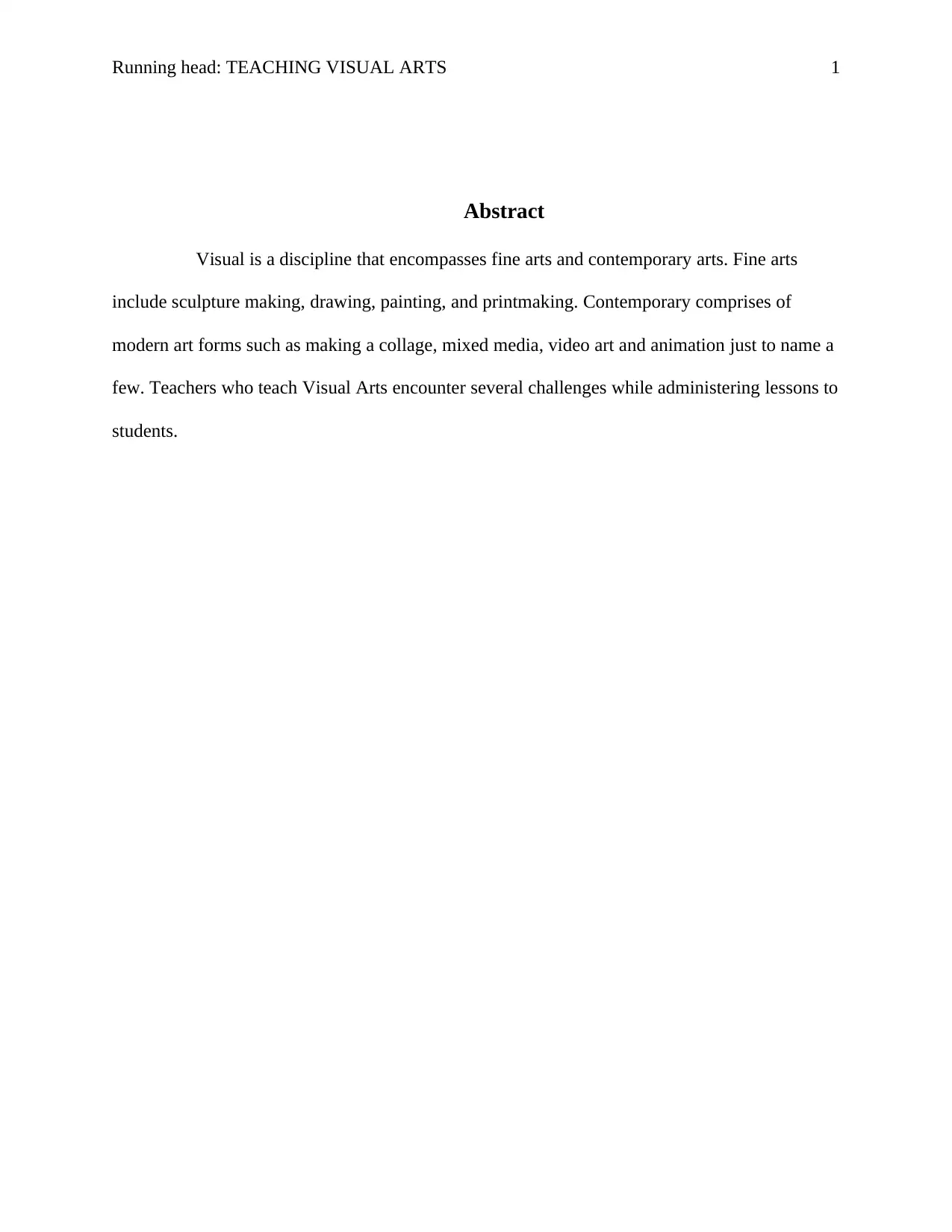
Running head: TEACHING VISUAL ARTS 1
Abstract
Visual is a discipline that encompasses fine arts and contemporary arts. Fine arts
include sculpture making, drawing, painting, and printmaking. Contemporary comprises of
modern art forms such as making a collage, mixed media, video art and animation just to name a
few. Teachers who teach Visual Arts encounter several challenges while administering lessons to
students.
Abstract
Visual is a discipline that encompasses fine arts and contemporary arts. Fine arts
include sculpture making, drawing, painting, and printmaking. Contemporary comprises of
modern art forms such as making a collage, mixed media, video art and animation just to name a
few. Teachers who teach Visual Arts encounter several challenges while administering lessons to
students.
Paraphrase This Document
Need a fresh take? Get an instant paraphrase of this document with our AI Paraphraser
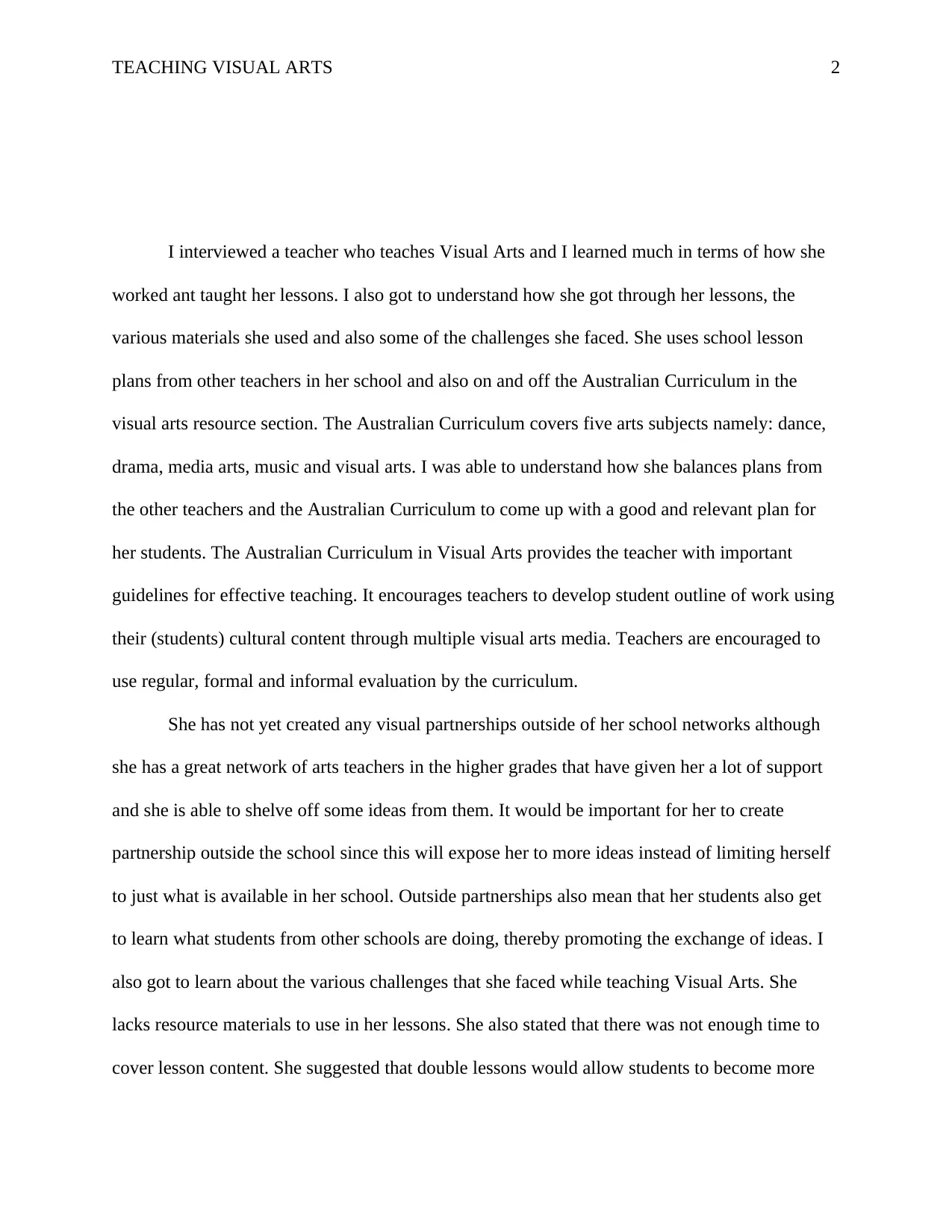
TEACHING VISUAL ARTS 2
I interviewed a teacher who teaches Visual Arts and I learned much in terms of how she
worked ant taught her lessons. I also got to understand how she got through her lessons, the
various materials she used and also some of the challenges she faced. She uses school lesson
plans from other teachers in her school and also on and off the Australian Curriculum in the
visual arts resource section. The Australian Curriculum covers five arts subjects namely: dance,
drama, media arts, music and visual arts. I was able to understand how she balances plans from
the other teachers and the Australian Curriculum to come up with a good and relevant plan for
her students. The Australian Curriculum in Visual Arts provides the teacher with important
guidelines for effective teaching. It encourages teachers to develop student outline of work using
their (students) cultural content through multiple visual arts media. Teachers are encouraged to
use regular, formal and informal evaluation by the curriculum.
She has not yet created any visual partnerships outside of her school networks although
she has a great network of arts teachers in the higher grades that have given her a lot of support
and she is able to shelve off some ideas from them. It would be important for her to create
partnership outside the school since this will expose her to more ideas instead of limiting herself
to just what is available in her school. Outside partnerships also mean that her students also get
to learn what students from other schools are doing, thereby promoting the exchange of ideas. I
also got to learn about the various challenges that she faced while teaching Visual Arts. She
lacks resource materials to use in her lessons. She also stated that there was not enough time to
cover lesson content. She suggested that double lessons would allow students to become more
I interviewed a teacher who teaches Visual Arts and I learned much in terms of how she
worked ant taught her lessons. I also got to understand how she got through her lessons, the
various materials she used and also some of the challenges she faced. She uses school lesson
plans from other teachers in her school and also on and off the Australian Curriculum in the
visual arts resource section. The Australian Curriculum covers five arts subjects namely: dance,
drama, media arts, music and visual arts. I was able to understand how she balances plans from
the other teachers and the Australian Curriculum to come up with a good and relevant plan for
her students. The Australian Curriculum in Visual Arts provides the teacher with important
guidelines for effective teaching. It encourages teachers to develop student outline of work using
their (students) cultural content through multiple visual arts media. Teachers are encouraged to
use regular, formal and informal evaluation by the curriculum.
She has not yet created any visual partnerships outside of her school networks although
she has a great network of arts teachers in the higher grades that have given her a lot of support
and she is able to shelve off some ideas from them. It would be important for her to create
partnership outside the school since this will expose her to more ideas instead of limiting herself
to just what is available in her school. Outside partnerships also mean that her students also get
to learn what students from other schools are doing, thereby promoting the exchange of ideas. I
also got to learn about the various challenges that she faced while teaching Visual Arts. She
lacks resource materials to use in her lessons. She also stated that there was not enough time to
cover lesson content. She suggested that double lessons would allow students to become more
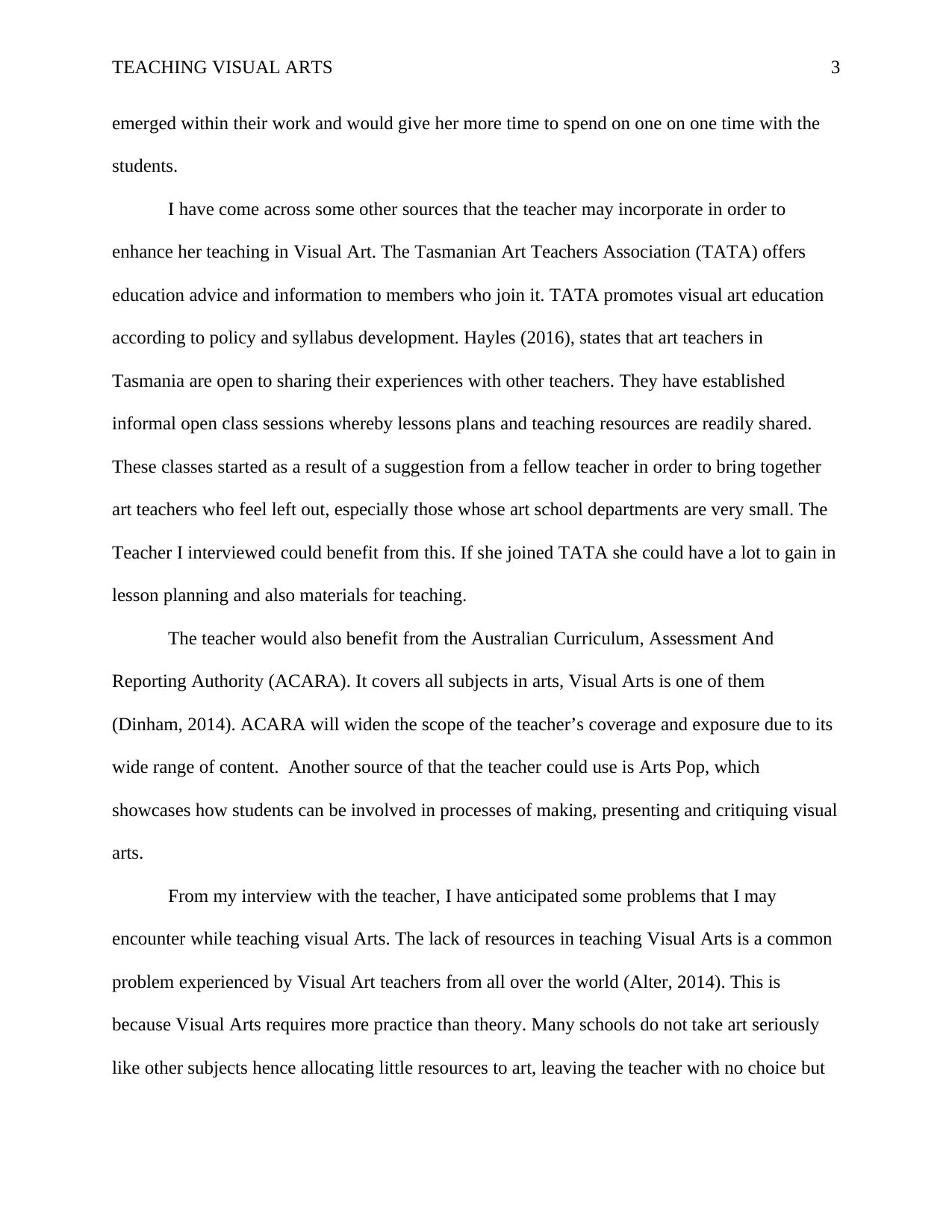
TEACHING VISUAL ARTS 3
emerged within their work and would give her more time to spend on one on one time with the
students.
I have come across some other sources that the teacher may incorporate in order to
enhance her teaching in Visual Art. The Tasmanian Art Teachers Association (TATA) offers
education advice and information to members who join it. TATA promotes visual art education
according to policy and syllabus development. Hayles (2016), states that art teachers in
Tasmania are open to sharing their experiences with other teachers. They have established
informal open class sessions whereby lessons plans and teaching resources are readily shared.
These classes started as a result of a suggestion from a fellow teacher in order to bring together
art teachers who feel left out, especially those whose art school departments are very small. The
Teacher I interviewed could benefit from this. If she joined TATA she could have a lot to gain in
lesson planning and also materials for teaching.
The teacher would also benefit from the Australian Curriculum, Assessment And
Reporting Authority (ACARA). It covers all subjects in arts, Visual Arts is one of them
(Dinham, 2014). ACARA will widen the scope of the teacher’s coverage and exposure due to its
wide range of content. Another source of that the teacher could use is Arts Pop, which
showcases how students can be involved in processes of making, presenting and critiquing visual
arts.
From my interview with the teacher, I have anticipated some problems that I may
encounter while teaching visual Arts. The lack of resources in teaching Visual Arts is a common
problem experienced by Visual Art teachers from all over the world (Alter, 2014). This is
because Visual Arts requires more practice than theory. Many schools do not take art seriously
like other subjects hence allocating little resources to art, leaving the teacher with no choice but
emerged within their work and would give her more time to spend on one on one time with the
students.
I have come across some other sources that the teacher may incorporate in order to
enhance her teaching in Visual Art. The Tasmanian Art Teachers Association (TATA) offers
education advice and information to members who join it. TATA promotes visual art education
according to policy and syllabus development. Hayles (2016), states that art teachers in
Tasmania are open to sharing their experiences with other teachers. They have established
informal open class sessions whereby lessons plans and teaching resources are readily shared.
These classes started as a result of a suggestion from a fellow teacher in order to bring together
art teachers who feel left out, especially those whose art school departments are very small. The
Teacher I interviewed could benefit from this. If she joined TATA she could have a lot to gain in
lesson planning and also materials for teaching.
The teacher would also benefit from the Australian Curriculum, Assessment And
Reporting Authority (ACARA). It covers all subjects in arts, Visual Arts is one of them
(Dinham, 2014). ACARA will widen the scope of the teacher’s coverage and exposure due to its
wide range of content. Another source of that the teacher could use is Arts Pop, which
showcases how students can be involved in processes of making, presenting and critiquing visual
arts.
From my interview with the teacher, I have anticipated some problems that I may
encounter while teaching visual Arts. The lack of resources in teaching Visual Arts is a common
problem experienced by Visual Art teachers from all over the world (Alter, 2014). This is
because Visual Arts requires more practice than theory. Many schools do not take art seriously
like other subjects hence allocating little resources to art, leaving the teacher with no choice but
⊘ This is a preview!⊘
Do you want full access?
Subscribe today to unlock all pages.

Trusted by 1+ million students worldwide
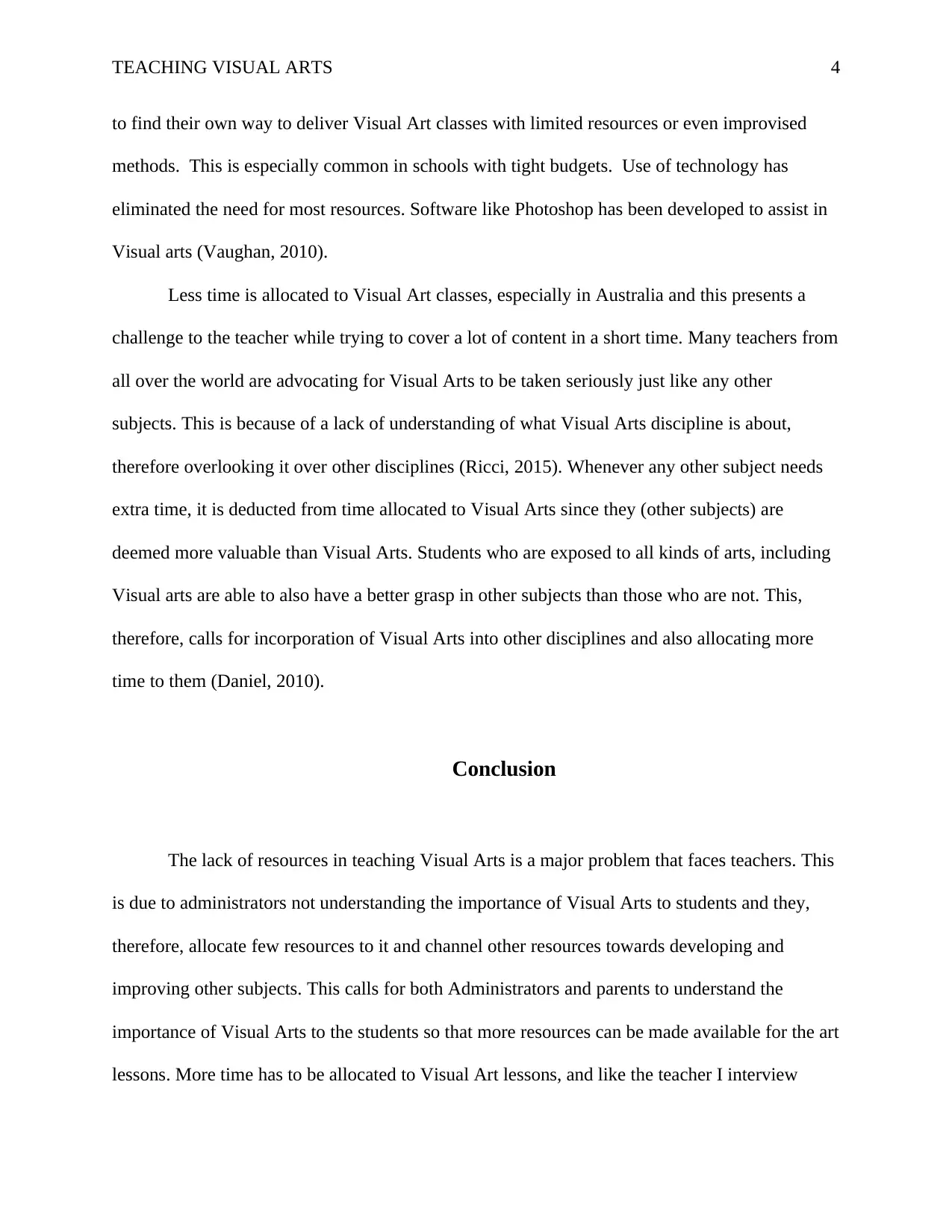
TEACHING VISUAL ARTS 4
to find their own way to deliver Visual Art classes with limited resources or even improvised
methods. This is especially common in schools with tight budgets. Use of technology has
eliminated the need for most resources. Software like Photoshop has been developed to assist in
Visual arts (Vaughan, 2010).
Less time is allocated to Visual Art classes, especially in Australia and this presents a
challenge to the teacher while trying to cover a lot of content in a short time. Many teachers from
all over the world are advocating for Visual Arts to be taken seriously just like any other
subjects. This is because of a lack of understanding of what Visual Arts discipline is about,
therefore overlooking it over other disciplines (Ricci, 2015). Whenever any other subject needs
extra time, it is deducted from time allocated to Visual Arts since they (other subjects) are
deemed more valuable than Visual Arts. Students who are exposed to all kinds of arts, including
Visual arts are able to also have a better grasp in other subjects than those who are not. This,
therefore, calls for incorporation of Visual Arts into other disciplines and also allocating more
time to them (Daniel, 2010).
Conclusion
The lack of resources in teaching Visual Arts is a major problem that faces teachers. This
is due to administrators not understanding the importance of Visual Arts to students and they,
therefore, allocate few resources to it and channel other resources towards developing and
improving other subjects. This calls for both Administrators and parents to understand the
importance of Visual Arts to the students so that more resources can be made available for the art
lessons. More time has to be allocated to Visual Art lessons, and like the teacher I interview
to find their own way to deliver Visual Art classes with limited resources or even improvised
methods. This is especially common in schools with tight budgets. Use of technology has
eliminated the need for most resources. Software like Photoshop has been developed to assist in
Visual arts (Vaughan, 2010).
Less time is allocated to Visual Art classes, especially in Australia and this presents a
challenge to the teacher while trying to cover a lot of content in a short time. Many teachers from
all over the world are advocating for Visual Arts to be taken seriously just like any other
subjects. This is because of a lack of understanding of what Visual Arts discipline is about,
therefore overlooking it over other disciplines (Ricci, 2015). Whenever any other subject needs
extra time, it is deducted from time allocated to Visual Arts since they (other subjects) are
deemed more valuable than Visual Arts. Students who are exposed to all kinds of arts, including
Visual arts are able to also have a better grasp in other subjects than those who are not. This,
therefore, calls for incorporation of Visual Arts into other disciplines and also allocating more
time to them (Daniel, 2010).
Conclusion
The lack of resources in teaching Visual Arts is a major problem that faces teachers. This
is due to administrators not understanding the importance of Visual Arts to students and they,
therefore, allocate few resources to it and channel other resources towards developing and
improving other subjects. This calls for both Administrators and parents to understand the
importance of Visual Arts to the students so that more resources can be made available for the art
lessons. More time has to be allocated to Visual Art lessons, and like the teacher I interview
Paraphrase This Document
Need a fresh take? Get an instant paraphrase of this document with our AI Paraphraser
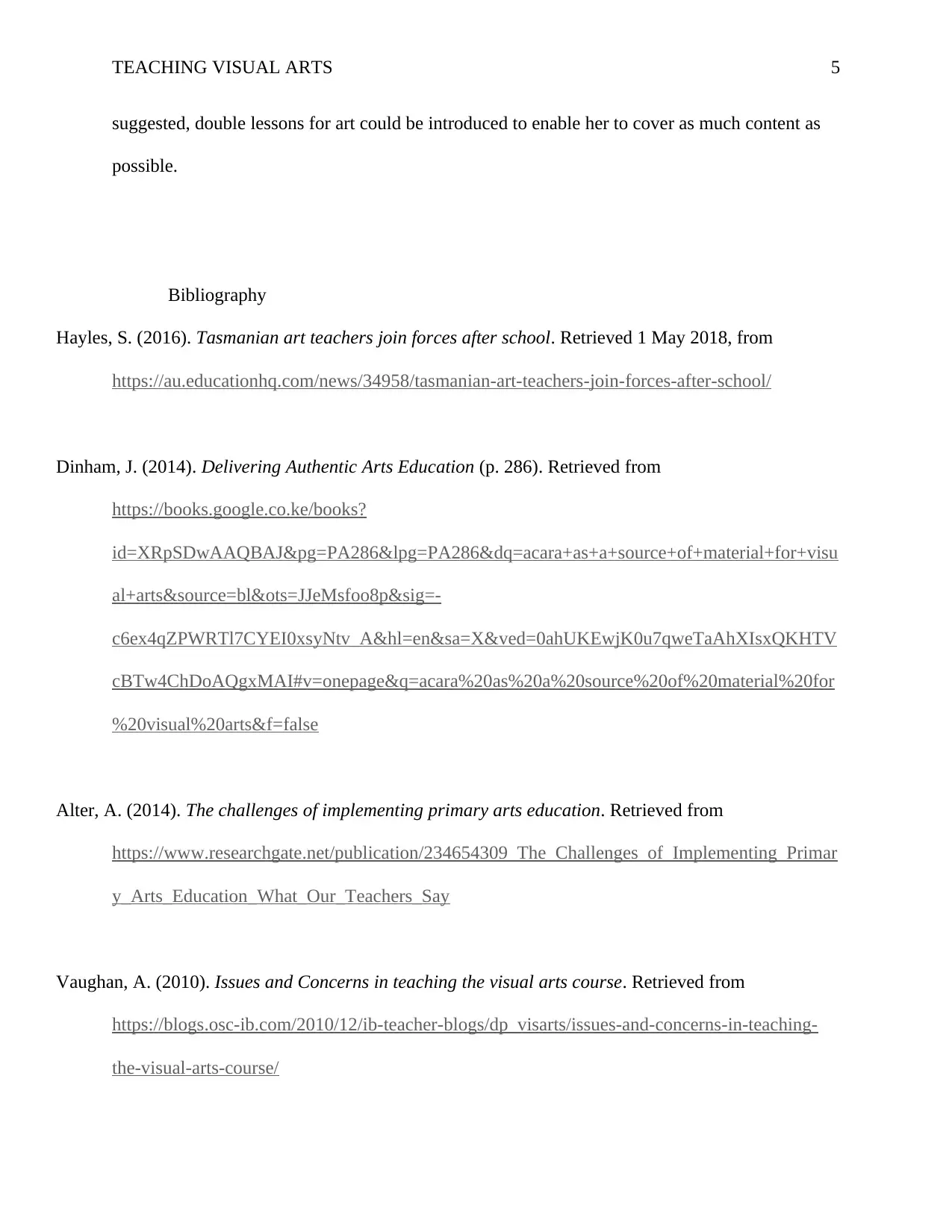
TEACHING VISUAL ARTS 5
suggested, double lessons for art could be introduced to enable her to cover as much content as
possible.
Bibliography
Hayles, S. (2016). Tasmanian art teachers join forces after school. Retrieved 1 May 2018, from
https://au.educationhq.com/news/34958/tasmanian-art-teachers-join-forces-after-school/
Dinham, J. (2014). Delivering Authentic Arts Education (p. 286). Retrieved from
https://books.google.co.ke/books?
id=XRpSDwAAQBAJ&pg=PA286&lpg=PA286&dq=acara+as+a+source+of+material+for+visu
al+arts&source=bl&ots=JJeMsfoo8p&sig=-
c6ex4qZPWRTl7CYEI0xsyNtv_A&hl=en&sa=X&ved=0ahUKEwjK0u7qweTaAhXIsxQKHTV
cBTw4ChDoAQgxMAI#v=onepage&q=acara%20as%20a%20source%20of%20material%20for
%20visual%20arts&f=false
Alter, A. (2014). The challenges of implementing primary arts education. Retrieved from
https://www.researchgate.net/publication/234654309_The_Challenges_of_Implementing_Primar
y_Arts_Education_What_Our_Teachers_Say
Vaughan, A. (2010). Issues and Concerns in teaching the visual arts course. Retrieved from
https://blogs.osc-ib.com/2010/12/ib-teacher-blogs/dp_visarts/issues-and-concerns-in-teaching-
the-visual-arts-course/
suggested, double lessons for art could be introduced to enable her to cover as much content as
possible.
Bibliography
Hayles, S. (2016). Tasmanian art teachers join forces after school. Retrieved 1 May 2018, from
https://au.educationhq.com/news/34958/tasmanian-art-teachers-join-forces-after-school/
Dinham, J. (2014). Delivering Authentic Arts Education (p. 286). Retrieved from
https://books.google.co.ke/books?
id=XRpSDwAAQBAJ&pg=PA286&lpg=PA286&dq=acara+as+a+source+of+material+for+visu
al+arts&source=bl&ots=JJeMsfoo8p&sig=-
c6ex4qZPWRTl7CYEI0xsyNtv_A&hl=en&sa=X&ved=0ahUKEwjK0u7qweTaAhXIsxQKHTV
cBTw4ChDoAQgxMAI#v=onepage&q=acara%20as%20a%20source%20of%20material%20for
%20visual%20arts&f=false
Alter, A. (2014). The challenges of implementing primary arts education. Retrieved from
https://www.researchgate.net/publication/234654309_The_Challenges_of_Implementing_Primar
y_Arts_Education_What_Our_Teachers_Say
Vaughan, A. (2010). Issues and Concerns in teaching the visual arts course. Retrieved from
https://blogs.osc-ib.com/2010/12/ib-teacher-blogs/dp_visarts/issues-and-concerns-in-teaching-
the-visual-arts-course/
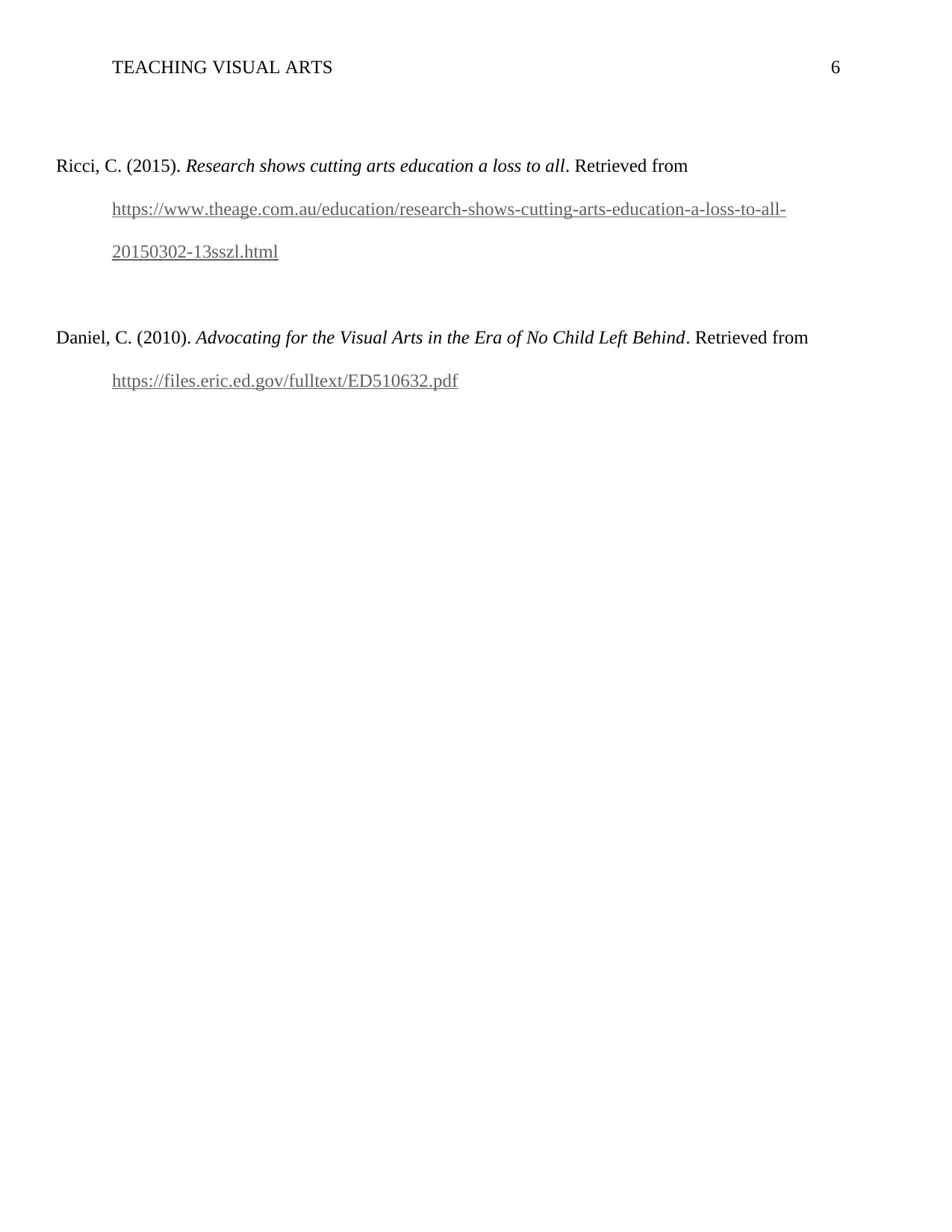
TEACHING VISUAL ARTS 6
Ricci, C. (2015). Research shows cutting arts education a loss to all. Retrieved from
https://www.theage.com.au/education/research-shows-cutting-arts-education-a-loss-to-all-
20150302-13sszl.html
Daniel, C. (2010). Advocating for the Visual Arts in the Era of No Child Left Behind. Retrieved from
https://files.eric.ed.gov/fulltext/ED510632.pdf
Ricci, C. (2015). Research shows cutting arts education a loss to all. Retrieved from
https://www.theage.com.au/education/research-shows-cutting-arts-education-a-loss-to-all-
20150302-13sszl.html
Daniel, C. (2010). Advocating for the Visual Arts in the Era of No Child Left Behind. Retrieved from
https://files.eric.ed.gov/fulltext/ED510632.pdf
⊘ This is a preview!⊘
Do you want full access?
Subscribe today to unlock all pages.

Trusted by 1+ million students worldwide
1 out of 6
Related Documents
Your All-in-One AI-Powered Toolkit for Academic Success.
+13062052269
info@desklib.com
Available 24*7 on WhatsApp / Email
![[object Object]](/_next/static/media/star-bottom.7253800d.svg)
Unlock your academic potential
Copyright © 2020–2025 A2Z Services. All Rights Reserved. Developed and managed by ZUCOL.





